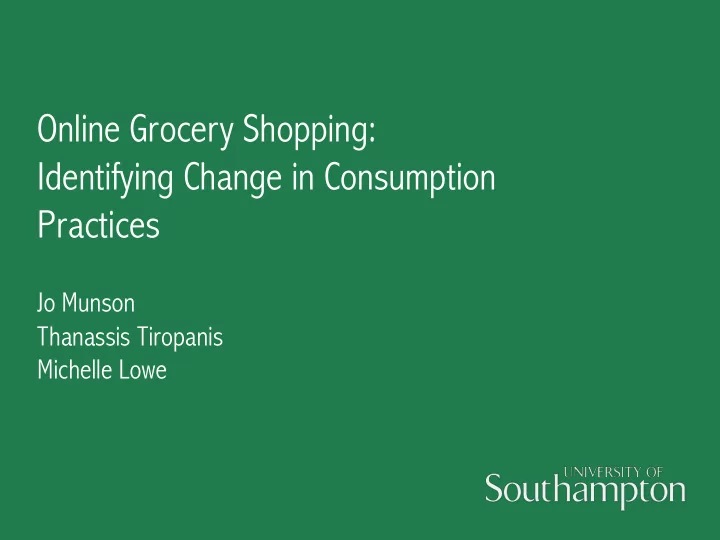

Online Grocery Shopping: Identifying Change in Consumption Practices Jo Munson Thanassis Tiropanis Michelle Lowe
E- commerce is big business, not least in the UK +16% UK online retail expenditure £133bn £115bn 2015 2016 Introduction
UK online grocery market is relatively small… Online, £11bn 2015 Offline, £142bn Introduction
…but projected to grow rapidly Online, £11bn 2015 Offline, £142bn Online, £18bn 2020 Offline, £213bn Introduction
Insight into online grocery consumer behaviour invaluable for retailers n Customer retention n Personalisation n Complementary service provision n Increasing LTV in low margin industry n Multi-channel planning Introduction
…and good for governments , academia and consumers too n Town planning and policy design for governments n Better quality services for consumers n Socio-technical understanding of consumer behaviour in academia Introduction
The problem … n Lack of good quality data Most research conducted is: n Synthetic lab-based n Survey / ‘intention’ based Introduction
The opportunity… and another problem n Access to WM Morrisons Plc (Morrisons) Google Analytics account But… n No comparable offline dataset available through Morrisons n Most comprehensive publicly available data covering online and offline grocery shopping in UK: ONS LCF survey Introduction
Aims of this study n Are there differences in consumption behaviours in online and offline grocery shopping in the UK? n Is the Morrisons sample representative of online grocery shopping at the national level? n Are online grocery shoppers price sensitive ? n Are online grocery baskets stable ? Aims of this study
Methodology & results • Are there differences in consumption behaviours in online and offline grocery shopping in the UK? • Is the Morrisons sample representative of online grocery shopping at the national level?
Dataset descriptions Morrisons sample n 986,973 transacted food and drink items from 41,201 users/households National level ‘population’ n Living Costs and Food (LCF) survey of 4,760 households, mapped back to general population Methodology
Variables used to compare Morrisons sample with national statistics Va Variable Food category Bread & cereals, Fruit & veg., Meat, Fish, Dairy & eggs, Confectionary, Non-alcoholic Drinks, Other Food freshness Fresh, Not Fresh Region NE, NW, E/W Midlands, SE, SW, East of England, Yorkshire, London, Wales, Scotland Methodology
Comparing online and offline baskets Null hypothesis 1 At the national level, the distribution of revenue between food categories for online and offline transactions is the same Result of χ 2 test n Strong evidence to reject null hypothesis n Confectionary & Meat overweight in offline sample n Other & non-alcoholic drinks overweight in online sample Methodology
Comparing Morrisons sample with ‘population’ Null hypothesis 2 The distribution of revenue between food categories for the online LCF 2016 and online Morrisons sample transactions is the same Result of χ 2 test n Some evidence to reject null hypothesis n Bread and cereals overweight in Morrisons sample Methodology
How does the Morrisons sample compare to the UK population distribution? Sample distribution relative to population < -4.75% -4.76 – +1.5% +1.51 – +7.75% > +7.75% Methodology
Comparing re-weighted Morrisons sample with ‘population’ Null hypothesis 3 The distribution of revenue between food categories for the online LCF 2016 and re-weighted online Morrisons sample transactions is the same Result of χ 2 test n Insufficient evidence to reject null hypothesis n Re-weighted sample not significantly different from ‘population’ Methodology
Comparing proportion of fresh and non-fresh products in online and offline baskets Null hypothesis 4 The distribution of revenue between fresh and non-fresh for the offline LCF 2016 and re-weighted online Morrisons sample transactions is the same Result of χ 2 test n Sufficient evidence to reject null hypothesis n Proportion of fresh products is larger in Morrisons sample Methodology
Methodology & results • Are online grocery shoppers price sensitive? • Are online grocery baskets stable?
Last page visited before adding products to basket Price ce s sensitive ve Sta Stable le Offers Shopping list Flash sales Favourites Sort by price ascending Suggested order Previous order Methodology
Average basket value £33.56 £20.93 Morrisons LCF (Offline) Results
Morrisons specific behaviour: Price sensitivity Price sensitive 23% Price insensitive 77% Offers 22% Search (price asc.) 1% Results
Morrisons specific behaviour: Basket Stability Favourites Disrupted product 36.3% adds 61.0% Stable 39% Shopping list Other 0.4% 1.6% Results
Conclusions , implications & future work
Conclusions n Differences in basket consumption between online and offline grocery shopping in the UK n Re-weighting Morrisons offers potential to represent national-level behaviour Conclusions
Conclusions n Some evidence that online consumers spend more on fresh products than offline, contrary to popular belief n Some evidence consumers are not as price-sensitive as retailers / current research suggests Conclusions
Future work n Examine behaviour by location , device , time n How the capacity to edit baskets affects basket composition n Qualitative investigation n Towards a ‘Theory of online grocery shopping behaviour’ Future work
Online Grocery Shopping: Identifying Change in Consumption Practices Jo Munson – j.munson@soton.ac.uk Thanassis Tiropanis Michelle Lowe https://link.springer.com/chapter/10.1007/978-3-319-70284-1_16
Recommend
More recommend